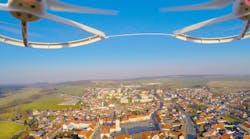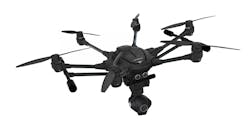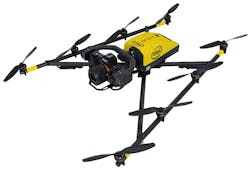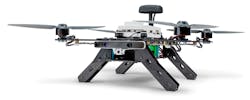Download this article in PDF format.
Intel’s presence at this year’s 2017 Xponential show (see “Intel Takes to the Air at Xponential 2017”) was significant, including CEO Brian Krzanich as the keynote speaker. The company has been active in buying up and partnering with a number of vendors in this space, and tying them in with other major investments such as augmented and virtual reality as well as artificial intelligence (see “Intel Buys Chip Startup Movidius, Betting on Machines That See and Think”).
Intel has highlighted its “Shooting Stars” multi-drone technology at events like Lady Gaga’s Super Bowl halftime show (Fig. 1), where 300 drones put on an impressive light show. In other events, it’s had up to 500 drones operating in coordination with each other.
1. For Lady Gaga’s Super Bowl halftime show, Intel flew 300 “shooting stars” drones to make a flag in the air.
The company’s venture capital arm, Intel Capital, includes investments in Airware, PrecisionHawk, Yuneec, and E-Volo. E-Volo’s Volocopter 2X is a vertical takeoff and landing (VTOL) aircraft powered purely by electricity and capable of carrying two passengers (Fig. 2). PrecisionHawk brings a collection of analytics, tracking, and mapping software that’s key in the commercialization of drones. Airware delivers database and management solutions for aerial devices.
2. The electric Volocopter 2X is a vertical takeoff and landing (VTOL) aircraft that can carry two passengers.
Yuneec’s Typhoon H (Fig. 3) takes advantage of Intel’s 3D RealSense technology (see “Getting a Sense for RealSense and Merged Reality”). The professional system has a gimbaled 4K camera and a flying time of over 25 minutes. The ground station can view 720p video in real time. The arms fold down for easy carrying and its retractable landing gear provides the camera with a 360-degree view.
3. Yuneec’s Typhoon H takes advantage of Intel’s 3D RealSense technology in addition to an HD camera.
RealSense modules (Fig. 4), which continue to advance while shrinking in size, are used in a variety of applications, such as augmented- and virtual-reality glasses. They add mixed reality support by detecting the surrounding environment in 3D.
4. Intel RealSense modules are available from electronic distributors. They use time-of-flight technology to provide 3D images.
Intel’s own Falcon 8+ optocoupler (Fig. 5), equipped with a high-precision GPS system, features redundancy and safety. It also leverages a triple-redundant autopilot technology called AscTec Trinity, which was developed by Ascending Technologies (now part of Intel). The Falcon 8+ is available now, unlike technology such as the Shooting Stars, which is currently a research platform.
5. The Falcon 8+ developed by Intel can continue to fly even if one propeller stops functioning. The optocoupler also features a redundant battery system.
In fact, much of the technology presented thus far is either research or end-user technology or services, but Intel offers much more in this space for developers. For instance, the Intel Aero Compute Board (Fig. 6), an open-source platform for building drones, is designed to support a range of sensors including the firm’s RealSense technology in addition to wireless plug-ins. The board is based on a quad-core, Atom x7-Z8750 processor with 4 GB of LPDDR3, 32 GB of eMMC flash, and a dual-band Wiresless-AC 8260 with 802.11ac support using a 2×2 MIMO configuration. It includes MIPI CSI-2 camera interfaces.
6. The Intel Aero Compute Board is an open-source platform for building drones.
The board can be used in projects ranging from drones to robotics. It’s also found in the Intel Aero Ready to Fly Drone (Fig. 7). The package features a ground station controller.
The open-source system runs Linux and the flight controller is preprogrammed with Dronecode PX4 from the Dronecode project and the PX4 project. PX4 autopilot is the core of the Dronecode project—it can be used in unmanned aerial vehicles (UAVs) as well as unmanned ground vehicles (UGVs). I suspect it may be usable in unmanned surface vehicles (USVs) and unmanned underwater vehicles (UUVs), too.
7. The Intel Aero Ready to Fly Drone is a quadcopter that integrates the Intel Aero Compute Board and a RealSense sensor.
Developers can also take advantage of the AirMap SDK. The SDK consist of a number of modules and interfaces, including the Pilot API, the Status API that supports geofencing, and the Flight API. The Flight API will support the Digital Notice and Awareness System (D-NAS). The system is being set up to address the FAA Modernization and Reform Act of 2012, which states drone operators have to give notice when flying within five miles of an airport. The SDK also has an iOS and Android component to interactively access airspace data.
Much of Intel’s endeavors in this area are open source or supporting open-source projects like Dronecode. Quite a bit of technology remains proprietary as well, some of which is done in conjunction with partners. Figuring out what’s available can be a challenge, but it may save a significant amount of development effort.









